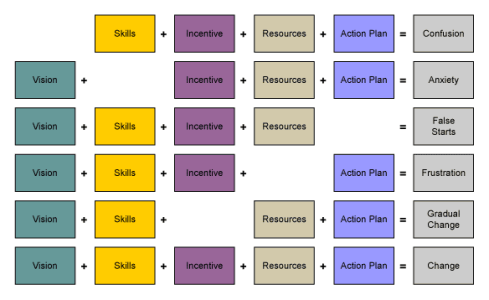I’ve been part of a complex change initiative for the past 18 months or so, at a large legacy organization that is struggling to catch up to the realities of doing business in this century. By which I mean, in large part, to live and make use of the digital world we now inhabit. One of the primary things we are trying to do is to get people to think about their business data in different ways, and to unify standards of data across a far-flung enterprise.
 People are asked to learn new tools and processes, the areas of traditional learning solutions. But also, to think about how their actions improve their teams, departments (lines of business) and client experiences, the ways in which they cooperate and collaborate, and the changing environment that is rolling out around them.
People are asked to learn new tools and processes, the areas of traditional learning solutions. But also, to think about how their actions improve their teams, departments (lines of business) and client experiences, the ways in which they cooperate and collaborate, and the changing environment that is rolling out around them.
“So,” my client asks, “how quickly can we expect them to learn this?”
I completely understand how she believes this to be a straightforward question, driven by her “learning” budget. She struggled with my answer: “It will take as long as it takes. And it will take something like a lifetime.” I see how that is not a terribly satisfying or reassuring response.
So, I turn it back to her learning experiences. I asked her what kind of phone she had. An Apple iPhone 7, as it happens. “How long did it take you to learn how to use it?” She hesitates, and then answers that she learned how to use it in the first few minutes.
“OK, do you use it in the same way today as you did the first day you got it?”
“No, of course I discover new things and new apps and what I can do with it all the time.” She is starting to catch on to my line.
I get her to see that she has an internal motivation to continually learn its many features, discover new apps (mostly via word of mouth and observation – social learning!) and keep up with her peers, if not her children.
Right. I explain it is very much akin to the same thing.
We can train people on the new technology platforms up to an advanced-beginner level. However, unless they have the motivation to learn, internalize why they should do so, and start out on their own journey of discovery through social learning, peer support (or pressure not to appear behind, if you like) and organizational allowance that learning is as much about trial and failure as it is about success, they are unlikely to ever achieve a state where we can say, “Now they’re done learning.”
In fact, we need to reset hearts and minds to never say they’re done learning. We are teaching a set of technologies, it’s true. But to live and adapt to the modern workplace means learning that is much more like the iPhone than it is like traditional corporate training.
Learn the basics, observe what others are doing, share your own discoveries, and adapt and learn constantly. How will it take you to learn to use a computer? As long as it takes, and it takes forever. That’s the world we live in.
Exactly. That’s where Learning & Development needs to be. Training, sure, if it’s needed (none was needed for the iPhone because it was well designed). But training is the starting blocks. Our primary function is to teach people to be learners. Our organizations depend on it.


 People are asked to learn new tools and processes, the areas of traditional learning solutions. But also, to think about how their actions improve their teams, departments (lines of business) and client experiences, the ways in which they cooperate and collaborate, and the changing environment that is rolling out around them.
People are asked to learn new tools and processes, the areas of traditional learning solutions. But also, to think about how their actions improve their teams, departments (lines of business) and client experiences, the ways in which they cooperate and collaborate, and the changing environment that is rolling out around them.


